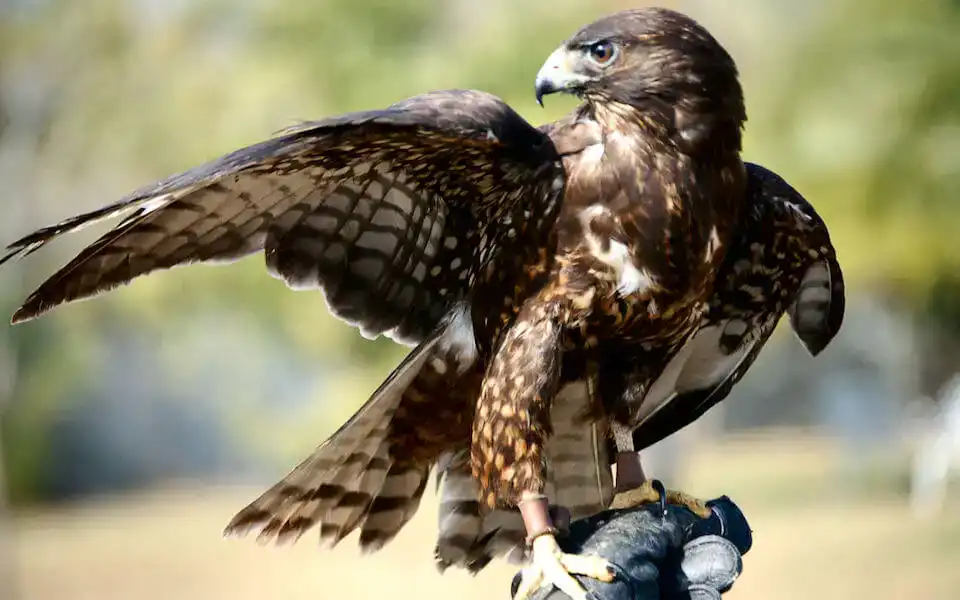Florida, known for its beautiful beaches and diverse wildlife, is also home to a fascinating group of predators—the hawks. These magnificent birds of prey, with their keen eyesight and powerful flight, dominate the skies and are a sight to behold for bird watchers and nature enthusiasts alike. In this blog post, we’ll explore eight hawks of Florida, either year-round or seasonally. Each species brings its unique charm, contributing to the rich biodiversity of the Sunshine State.
1. Red-Shouldered Hawk (Buteo lineatus): The Woodland Sentinel
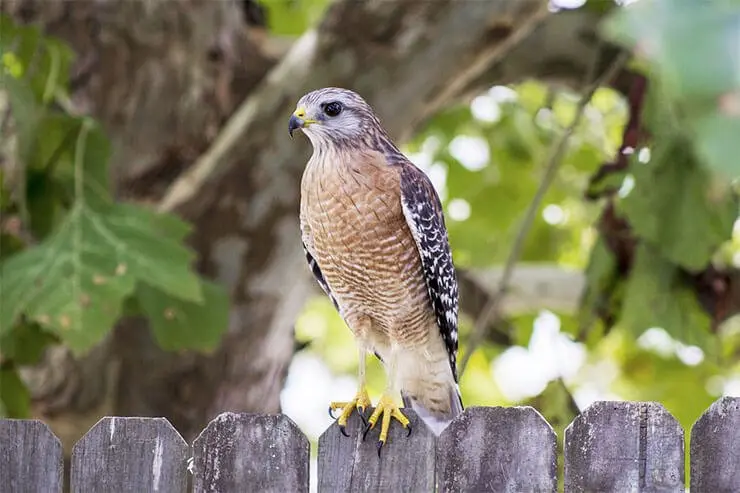
The Red-Shouldered Hawk is perhaps the most iconic hawk in Florida, easily recognized by its distinctive reddish-brown shoulders and banded tail. These hawks are year-round residents of the state, often found in deciduous swamps and bottomland hardwood forests. Their preference for habitats near water makes Florida’s diverse ecosystems an ideal home.
Physical Characteristics and Behavior:
- Size: Measuring between 16.9-24 inches with a wingspan of 37-43.7 inches, the Red-Shouldered Hawk is a medium-sized bird of prey.
- Diet: This species primarily preys on small mammals such as mice, voles, and moles. They are also known to eat small birds and amphibians, especially in winter when mammal populations decline.
- Nesting Habits: Red-Shouldered Hawks are known for their monogamous and territorial nature. They build their nests in tall trees, often reusing them year after year. The mating season begins in April, marked by the male’s aerial displays to attract a mate.
Conservation Status:
Once threatened by habitat loss and pesticide use, the Red-Shouldered Hawk population has stabilized thanks to conservation efforts. The banning of harmful pesticides like DDT and habitat protection have allowed these birds to thrive once more.
Where to Spot Them:
These hawks are commonly seen throughout southern Florida and east of Orlando. They are best spotted by listening for their distinctive call and looking for them perched high in trees near water bodies.
2. Northern Harrier (Circus hudsonius): The Marsh Glider
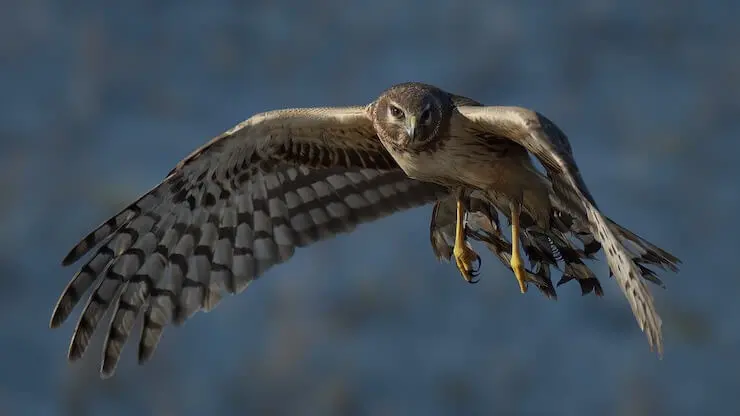
Known for its owl-like face and unique hunting style, the Northern Harrier is a winter visitor in Florida, arriving in September. These birds are often seen gliding low over marshes and grasslands, making them a favorite among bird watchers.
Physical Characteristics and Behavior:
- Size: Northern Harriers are large hawks, measuring 18.1-19.7 inches in length, with a wingspan of 40.2-46.5 inches.
- Diet: They primarily hunt small mammals, such as voles and ground squirrels, but will also take small birds. Their hunting method involves flying low and listening for prey before swooping down.
- Nesting Habits: Unlike most raptors, Northern Harriers are polygynous, with one male mating with up to five females. They build their nests on the ground in open areas, using twigs and soft materials.
Conservation Status:
While the Northern Harrier has a large range and is not considered threatened, habitat loss and prey poisoning pose ongoing risks. Conservation of wetlands and grasslands is crucial for their continued survival.
Where to Spot Them:
To see Northern Harriers in action, visit Florida’s marshes and open fields, especially around Tallahassee and northwest of Miami. Look for their graceful gliding flight, often close to the ground.
3. Red-Tailed Hawk (Buteo jamaicensis): The Roadside Watcher

One of the most widespread hawks in North America, the Red-Tailed Hawk is a year-round resident in Florida. Known for its distinctive rusty-red tail, this large raptor is commonly seen perched on fence posts and telephone poles, scanning for prey.
Physical Characteristics and Behavior:
- Size: The Red-Tailed Hawk is one of the largest hawks, with a length of 19.7-25.6 inches and a wingspan of 44.9-52.4 inches.
- Diet: Their diet consists mainly of small mammals like voles, rats, and rabbits. They are opportunistic hunters, also preying on birds and reptiles.
- Nesting Habits: Red-Tailed Hawks prefer tall trees or nest boxes for nesting. They are known to reuse the same nest year after year. Courtship involves impressive aerial displays and sometimes offering food to the female.
Conservation Status:
These hawks have adapted well to human-altered landscapes, and their population has remained stable. They are not currently at risk, although illegal shooting and poisoning are concerns.
Where to Spot Them:
Red-Tailed Hawks are visible throughout Florida, particularly along roadsides where they can easily spot their prey. Their large size and red tail make them easy to identify.
4. Cooper’s Hawk (Accipiter cooperii): The Stealthy Hunter
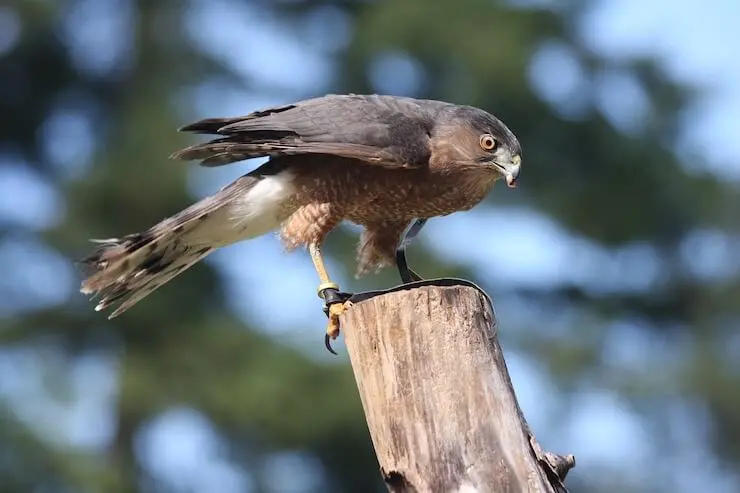
Cooper’s Hawk, a medium-sized raptor, is a master of agility and speed. These birds are common in wooded areas and urban environments where they often hunt birds, making them a frequent visitor to backyard feeders.
Physical Characteristics and Behavior:
- Size: They measure 14.6-15.3 inches in length with a wingspan of 24.4-35.4 inches.
- Diet: Cooper’s Hawks primarily prey on small birds, but they will also hunt small mammals and reptiles. Their hunting style involves high-speed chases through dense vegetation.
- Nesting Habits: Nests are typically built in tall trees, often using old nests of other birds. Males perform spectacular aerial acrobatics to attract females, and once paired, both sexes participate in nest building.
Conservation Status:
Historically affected by pesticide use, Cooper’s Hawks have rebounded in numbers. They are now commonly seen across North America, benefiting from the abundance of prey around human settlements.
Where to Spot Them:
These hawks are widespread in central Florida. They are stealthy hunters, so look for them in dense forests or near bird feeders, where they lie in wait for unsuspecting prey.
5. Sharp-Shinned Hawk (Accipiter striatus): The Agile Predator
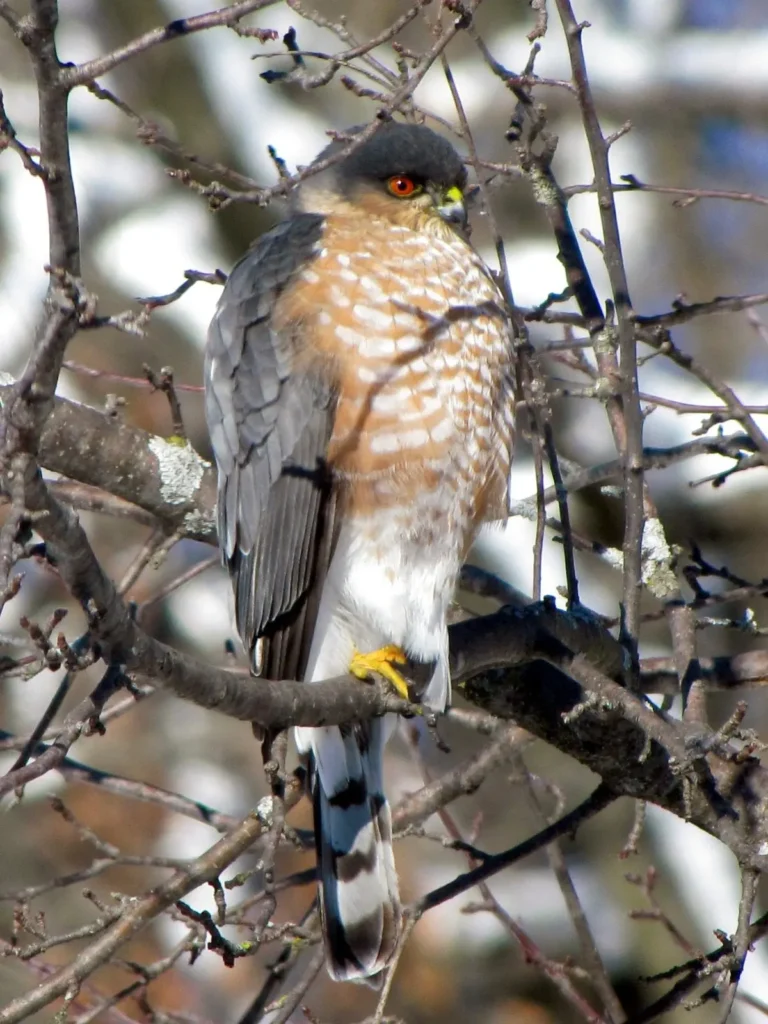
The smallest hawk in Florida, the Sharp-Shinned Hawk, is known for its agility and stealth. These hawks are winter visitors to Florida, migrating from their northern breeding grounds.
Physical Characteristics and Behavior:
- Size: Sharp-Shinned Hawks are small, with a length of 9.4-13.4 inches and a wingspan of 16.9-22.1 inches.
- Diet: Their diet is similar to that of Cooper’s Hawks, consisting mainly of small birds and mammals. They are adept at catching prey mid-air or ambushing them from cover.
- Nesting Habits: These hawks nest in dense coniferous forests, often building their nests close to the trunk for camouflage. During courtship, they perform aerial displays similar to other hawks.
Conservation Status:
Like many other raptors, Sharp-Shinned Hawks were affected by DDT. However, their populations have since recovered, aided by the increase in bird feeders, which provide a steady food source.
Where to Spot Them:
Sharp-Shinned Hawks are most commonly seen in Florida during the winter months. They are best observed in or near forests, where they glide over the terrain or hide in thick bushes.
6. Short-Tailed Hawk (Buteo brachyurus): The Rare Resident

The Short-Tailed Hawk is a unique species, with Florida being the only state in the U.S. where they are found. These secretive birds are primarily dark brown, with a pale underside, and are often seen soaring high above the ground.
Physical Characteristics and Behavior:
- Size: Measuring 15-17 inches in length with a wingspan of 32.6-40.5 inches, the Short-Tailed Hawk is a medium-sized raptor.
- Diet: Their diet mainly consists of small birds, which they hunt using a technique called kiting, where they hover in place using headwinds.
- Nesting Habits: Little is known about their nesting habits, but they are believed to nest in tall pine or cypress trees. The nests are bulky and well-hidden.
Conservation Status:
The Short-Tailed Hawk is considered of least concern, although it is relatively uncommon. Habitat preservation is important for maintaining their small population in Florida.
Where to Spot Them:
Look for Short-Tailed Hawks in the central parts of peninsular Florida. They are best spotted during the fall migration in the Florida Keys and Everglades National Park.
7. Broad-Winged Hawk (Buteo platypterus): The Migratory Marvel

The Broad-Winged Hawk is known for its spectacular migrations, where thousands of individuals gather in large flocks to journey to South America for the winter. In Florida, these hawks are seen year-round, with breeding populations in the northern part of the state.
Physical Characteristics and Behavior:
- Size: Broad-Winged Hawks are relatively small, measuring 13.4-17.3 inches in length with a wingspan of 31.9-39.4 inches.
- Diet: They have a varied diet, feeding on insects, amphibians, small mammals, and birds. Their hunting method involves perching and waiting for prey to appear.
- Nesting Habits: They build nests in trees, often near water, using sticks and lining them with softer materials. Both sexes help build the nest and care for the young.
Conservation Status:
The population of Broad-Winged Hawks is stable, but habitat loss remains a concern. Their migration routes and breeding habitats need protection to ensure their survival.
Where to Spot Them:
Broad-Winged Hawks can be observed in northern Florida, especially during migration periods. Look for them in forested areas and near water bodies.
8. Swainson’s Hawk (Buteo swainsoni): The Nomadic Hunter
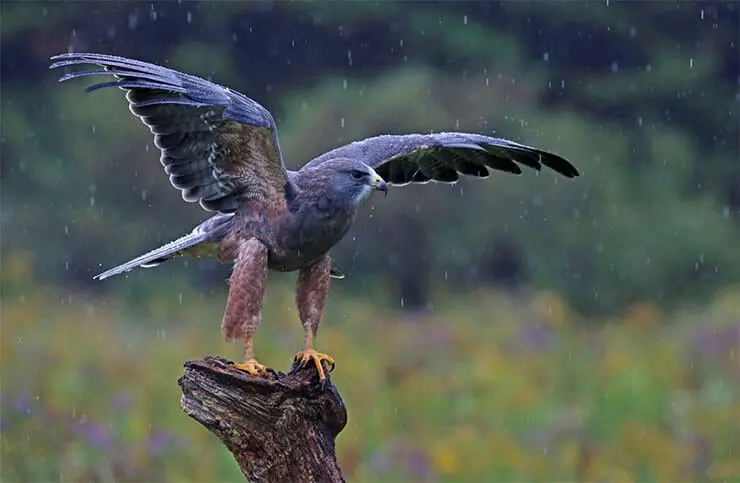
Swainson’s Hawk is a rare visitor to Florida, seen primarily during migration. These hawks are known for their long-distance travel, migrating from North America to Argentina.
Physical Characteristics and Behavior:
- Size: They are medium to large-sized hawks, measuring 17-22 inches in length with a wingspan of 46-54 inches.
- Diet: Their diet varies with the season—feeding on small mammals and reptiles during breeding and switching to insects like grasshoppers during migration.
- Nesting Habits: Swainson’s Hawks build their nests in isolated trees or on cliffs. They show strong site fidelity, often returning to the same nesting area year after year.
Conservation Status:
These hawks face threats from habitat loss and pesticide use, particularly in their wintering grounds. Conservation efforts focus on reducing pesticide use and protecting migratory corridors.
Where to Spot Them:
Swainson’s Hawks are most likely to be seen in the western parts of Florida during migration. They are rare, so sightings are considered a special treat.
Protecting Florida’s Hawks: A Call to Action
Florida’s hawks play a crucial role in the ecosystem, controlling rodent populations and helping to maintain the balance of nature. As top predators, their presence indicates a healthy environment. However, these magnificent birds face numerous threats, including habitat destruction, pollution, and climate change.
What You Can Do:
- Support Conservation Efforts: Join local conservation groups that focus on preserving habitats and protecting wildlife. Many organizations work to safeguard the natural areas that hawks need to thrive.
- Reduce Pesticide Use: Pesticides can poison hawks indirectly through their prey. Opt for natural pest control methods and support organic farming practices.
- Create Bird-Friendly Spaces: If you live in an area frequented by hawks, consider planting native trees and shrubs that provide habitat for their prey. Keeping bird feeders and water sources clean can also help attract the small birds that hawks hunt.
- Participate in Citizen Science: Join programs like the Audubon’s Christmas Bird Count or the Hawk Migration Association’s annual count to help track hawk populations and contribute to scientific research.
Conclusion: Celebrating the Majesty of Florida’s Hawks
The hawks of Florida are a testament to the beauty and complexity of nature. Each species, with its unique adaptations and behaviors, adds to the rich tapestry of life that makes Florida’s wilderness so special. By learning about these incredible birds and taking steps to protect their habitats, we can ensure that they continue to soar in Florida’s skies for generations to come. Whether you’re a seasoned birder or a casual nature lover, the sight of a hawk in flight is a reminder of the wildness that still exists, even in our modern world.
FAQs: Hawks of Florida
What kind of hawks are in florida?
Florida is home to various species of hawks, including the Cooper’s hawk, which is much like the merlin in its hunting prowess. These different types of hawks can often be seen looking for prey in agricultural fields and open areas. The American kestrel, one of the smallest hawks and falcons, has a distinctive short tail and a colorful upperparts pattern. During the breeding season, these birds build nests to raise their young, feeding primarily on small mammals like mice and voles.
In Florida, you can also find the crested caracara, which has a striking blackish-brown plumage and a bold beak. This bird often hunts in small flocks, utilizing its sharp talon to catch prey. Hawks are the smallest of the raptors, but their efficient flight pattern allows them to soar gracefully while they search for food. Their primary diet consists of small birds and mammals, making them vital for maintaining ecological balance throughout North America.
What are the main characteristics of the red-shouldered hawk?
The red-shouldered hawk is known for its distinctive plumage, featuring reddish-brown shoulders and a striking pattern of white and dark brown on its wings and tail. This species has a medium size, typically measuring around 18-24 inches in length. They have a loud, distinctive call that sounds like a series of “kree-kree-kree” notes. Their preferred habitats include wooded areas, swamps, and near water bodies, making them a common sight in Florida.
How do short-tailed hawks differ from other hawk species?
Short-tailed hawks are unique in their plumage, which can vary significantly between the dark and light morphs. The dark morph has a solid dark appearance, while the light morph has a more mottled look with white underparts. These hawks are smaller compared to other buteos and are known for their agility in flight. They primarily hunt small birds and rodents in open areas such as grasslands and fields, commonly found in Florida.
What is the diet of red-shouldered hawks?
The diet of red-shouldered hawks mainly consists of small mammals, reptiles, and amphibians. They are particularly fond of eating frogs and small rodents, making them effective hunters in their preferred habitats. They often hunt from a perch, scanning the ground for potential prey before diving down to catch it. In Florida, their diet may also include various species of birds, adding to their versatility as hunters.
Where can you find falcons in Florida?
Falcons, including the peregrine falcon, can be found in various habitats across Florida, from coastal areas to urban environments. They are often seen soaring high in the air or perched on tall structures, scanning for prey. Peregrine falcons are particularly known for their incredible speed and are often found nesting on high cliffs or tall buildings in cities. In the Florida Keys, these birds can be spotted hunting for small birds and other prey.

